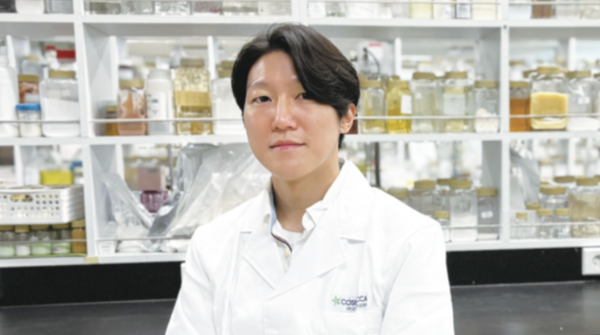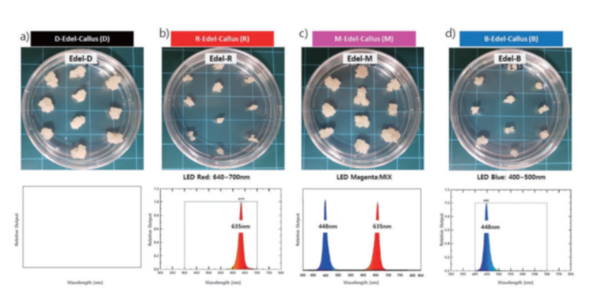[INTERVIEW] - Go Hoon, Senior Researcher, CCS, Cosmecca Korea

Cosmeca Korea's technology research institute discovered a case showing an increase in extracellular endoplasmic reticulum in plants exposed to purified light (LED light source), focusing on the fact that wavelengths in specific regions help plant growth.
Edelweiss was used in this study. Edelweiss has excellent antioxidant properties by suppressing free radicals that cause skin aging, and contains glycoflavonoids and leontopodic acid.
An official from Cosmecca Korea Technology Research Institute said, “To date, there has been no report of an increase in extracellular endoplasmic reticulum (EVs) in plants exposed to an LED light source, and this is the first case showing an increase in extracellular endoplasmic reticulum (EVs) in plants exposed to a purified light source.”
SCI (Science and Technology Citation Index) level academic journals also recognized this research achievement. The development of technology to increase plants and plant cell tissues (EVs, Extracellular Vesicles) submitted by Cosmecca Korea Research Institute, and the related research paper 'Technology for increasing plants and plant cells' was published by CIMB (Current Issues in Molecular Biology) on December 16, 2023 (impact factor 3.1). CIMB Journal is a Swiss-based open access journal that publishes reviews in all areas of molecular biology and molecular microbiology. Article Title: ‘Improvement in Yield of Extracellular Vesicles Derived from Edelweiss Callus Treated with LED Light and Enhancement of Skin Anti-Aging Indicators.’(https://www.mdpi.com/1467-3045/45/ 12/634)
Go Hoon, senior researcher at CCS, joined Cosmecca Korea's CIR Center in 2016 and is conducting research on cosmetic formulations. CCS (Cosmecca Complex Skincare) Research Institute is responsible for Cosmecca Korea's basic cosmetics research. Divided into Emulsion Lab., Skin Toner &Mask Lab., Hair & Cleansing Lab., and Fragrance Lab., basic cosmetics research and development is carried out from skin care to hair & body. In addition, the Center provides total services optimized for global business that meet the needs of domestic and overseas customers.
Researcher Go said, “Recent cosmetics consumers who appreciate value consumption are highly interested in vegan cosmetics, and by researching and developing vegan cosmetics, I am participating in a valuable cause.” He added, “Based on research on plant-derived materials, we will work harder to develop high-value vegan cosmetics beneficial to the skin.”
Q. Please explain the main content of this paper.
As a result of an experiment to improve the productivity of Edelweiss extracellular endoplasmic reticulum (EVs) using light-emitting diode (LED) light source, an increase in productivity and improvement in skin aging indicators were confirmed at specific wavelengths. In this paper, it was confirmed that edelweiss callus treated with a specific wavelength has the effect of △ improving the production of extracellular endoplasmic reticulum △ effectively suppressing the production of active oxygen radicals △ suppressing melanin production through extracellular melanin analysis. The research was conducted together with GFC Research Institute Director Kim Mi-jeong, who is also the co-author of the paper.
Q. What is the significance of this paper?
Callus is dubbed as plant stem cell from which gives rise to extracellular vesicles (EVs). It has recently been revealed that exosomes are a key component of human stem cell culture media. It was difficult to identify these exosomes from microorganisms and plants. Exosome research in plants is very rare. In theory, a plant pathogen can be used to increase the production of exosomes, but this cannot be used in practice due to aesthetic and safety issues. This research is aimed at increasing exosomes and its productivity using light such as LED. It’s significant because it is the first report of its kind in the world.

Q. They say it is difficult to achieve results in callus research. What drove you to start this research?
Callus is a highly dividing tissue created around the wound when a plant is injured and is called ‘plant stem cell’. Callus culture is a very difficult method. There are many things to pay attention to, such as temperature, humidity, incubation period, and medium composition. It is also a very difficult technology that can cause enormous damage if contamination occurs in mass culture. However, callus research also has many advantages. Callus research is a technology for growing plants that are likely to become extinct. It also allows precise control of bioactive substances when cultured under callus conditions. Marketing-wise, it is known as plant stem cells. I believe it is a high value-added technology in the cosmetics industry which is also conducive to protecting the environment.
Q. How will this paper help the cosmetics industry?
Consistent results were confirmed not only with edelweiss, but also with centella asiatica and ginseng. We expect that the development of cosmetics using various species of plant-derived extracellular endoplasmic reticulum will help improve skin condition. In the future, we believe that we will be able to strengthen our competitiveness in research on plant-derived materials for the development of vegan cosmetics.
For more research content, and continuation of the interview, please visit THE K BEAUTY SCIENCE website.
LED 광원으로 에델바이스·인삼·병풀 엑소좀 생산성 증가 < RESEARCH < NEWS < 기사본문 - THE K BEAUTY SCIENCE (thekbs.co.kr)

